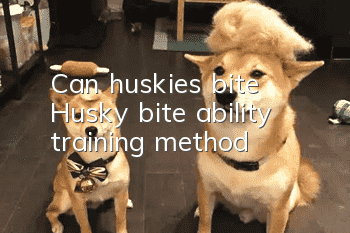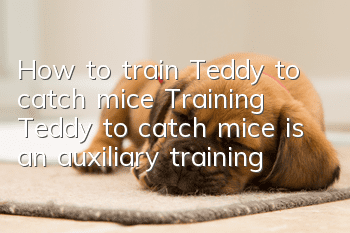Can huskies bite? Husky bite ability training method

The purpose of the bite is that under the command of the Husky owner, the dog can fight with criminals fiercely and alertly and capture them.
The passwords are "attack" and "release"; the auxiliary passwords are "attention".
1. Methods and steps for training Husky’s biting ability
Step one: Cultivate ferocity. Choose an experienced trainer and hide it after being appropriately disguised. The dog owner will tie the dog at a certain distance from the trainer's hiding place, and the dog owner will stand next to the dog. The assistant trainer holds a stick in his right hand and wears a protective sleeve in his left hand. He emerges from a hiding place and makes various violent movements from far to near. He hits the ground with a whip or stick, sometimes attacks and retreats, and tries every possible means to tease the dog and make it bark wildly. The dog owner encourages the dog to pounce on the assistant trainer and rewards it with the "good" command. After the dog's ferocity is aroused, the assistant trainer can walk up to the dog, and when the dog opens its mouth, hand over the protective sleeve to the dog and let the dog bite; when the dog bites and persists, the assistant trainer can take off the protective sleeve. And continue to tease the dog with a stick to make the dog hostile to the assistant trainer; at this time, the assistant trainer should retreat to the hiding place while teasing. After several times of this kind of training, when the dog can successfully complete the training subjects, it can move to the next step and training.
Step 2: Train a single dog to bite. The training venue is selected in advance and the assistant trainers are hidden in the training venue. After the dog owner leads the dog to the training venue, he makes the dog sit upright in a hidden place facing the assistant trainer. The dog owner adopts a half-crouching position and gives the "attention" command to the dog, and the assistant trainer makes a sound to alert the dog; Stop for a moment, then emerge from hiding with a stick or tree stick, keep hitting the ground and making sneaky movements. When the dog becomes ferocious enough to bite the assistant trainer, the dog owner should give the "attack" command. Let the dog pounce and bite; at this time, the assistant trainer should make an action of retreating in fear, and finally run away in defeat. The dog owner should continue to encourage the dog by issuing "attack" and "good" commands, and then end the training.
Step Three: Train the dog to "let go". After repeated training with the above method, if the dog dares to attack and bite the assistant trainer and keeps biting, the dog should be trained to "let go". The basic method is that after the dog owner makes the dog bite the assistant's sleeve, the assistant resists for a while, then lowers his arm so that the sleeve is close to the ground and remains motionless. At this time, the dog owner lowers the " "Release" command and pull the leash back slightly. Some dogs will let go as long as they hear the "release" command from their owner.However, some dogs will not let go in this situation. The trainer should repeat the command, pull the leash back hard, and use his left hand to cut the bridge of the dog's nose or pinch the dog's thigh to force the dog to let go.
When the dog develops preliminary conditioned reflexes, the training distance will gradually be increased to the point where the dog can be commanded to "release" from a longer distance.
Step 4: Monitor training. After the above training is completed, you can start training the dog's ability to monitor the bitten object. The method is that the dog owner uses a long leash to control the dog. When the dog bites the assistant, the owner tells the dog to let go. The assistant stops teasing and raises his hands to surrender. The dog owner orders the dog to monitor the assistant. If the dog looks around or attempts to return to its owner, the trainer should immediately escape or resist, redirecting the dog to attack the assistant; when the dog bites the assistant, the trainer should immediately stop fighting, and the dog owner Let the dog watch again. After repeated training in this way for many times, the dog will be able to develop the ability to monitor and monitor the bite target.
Step 5: Escort training. The method is that after the dog bites the trainer and monitors it for a while, the dog owner should return to the left side of the dog, tie the dog with a leash, let the dog continue to monitor the trainer, and instruct the trainer to get up and walk. The owner of the dog is expected to follow the assistant trainer within a distance of 5 to 10 meters; during the process, the dog owner should continue to let the dog walk while monitoring the assistant trainer. If the assistant trainer escapes or resists, the dog owner should subdue him again. After being escorted for a certain distance, the hypothetical enemy can be handed over to another assistant trainer to take away. Then, reward the dog and end the training.
After the first few snapping and biting decomposition movements are completed, combination training can be carried out. That is, without a training rope, the dog completely obeys the owner's command and performs a complete set of actions such as long-distance bite, release, surveillance, and escort.
2. Precautions for bite training
1. Be sure to check the protective gear before training to prevent accidents.
2. The assistant trainer’s teasing must be just right, and the movements should not be too sudden or cause the dog to suffer, so as not to affect the dog’s desire to bite.
3. During the dog chasing and biting process, you should pay attention to the flexibility of training to avoid the dog's excitability being reduced due to difficulty in breathing. At the same time, you should also pay attention to the dog's physical consumption and let the dog rest in a timely manner.
- What should you pay attention to when cutting your dog’s nails?
- Is a dog crazy if it suddenly bites its owner? Or it treats you like a slave! How does the master regain his status as the boss?
- What should I do if my Eurasian dog eats too much and has diarrhea?
- Dogs are naturally active and are always prone to getting into trouble! The owner can learn how to deal with these common injuries.
- What kind of dog food is good for Tibetan Mastiffs? What foods are healthier to eat?
- How to teach a dog to pick up things
- What kind of food is good for German Shepherd dogs and an introduction to their personality traits
- Cause Analysis and Treatment of Frequent Urination in Golden Retrievers
- The pros and cons of eating jerky for dogs
- What should I do if my dog has diarrhea after changing the dog food?



